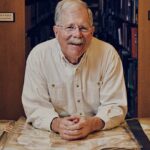Cities inevitably change through the decades. People move in and out. Businesses come and go. Often times, these shifts are most obvious in your own neighborhood.
Author and historian John Gurda has been reflecting on changes surrounding his childhood home in Milwaukee. He talks about how waves of immigration continue adding to the rich history of this beloved neighborhood.
==
I’ve decided what I want to be when I retire. Not a teller of cautionary tales to the young, not an ache-by-ache chronicler of my ongoing deterioration, and not, heaven forbid, a golfer.
What I want to be is something much simpler: an old guy on a bike who rides around looking at things.
I might stop once in a while to buy a donut, raise a glass of beer, or fall into casual conversation, but I’ll mainly be a witness to change, content to observe the passing scene and enjoy what poet Wallace Stevens called, “The pleasures of merely circulating.”
I had a foretaste of that experience on a recent two-wheeled tour of my first neighborhood. Until I was eight years old, my family lived in Layton Park, on the southern edge of Milwaukee’s Old South Side.
The reason we lived there was generational. My Polish grandparents, John and Mary Gurda, ran a hardware store in the heart of the neighborhood, at 32nd and Lincoln, from 1915 to 1965. My father, Art, was the oldest of four children raised behind the store.
When he and my mother, Clare, a farm girl from western Wisconsin, settled in Milwaukee after World War II, it was entirely natural for them to build a little house on South 34th Street, only eight blocks from the hardware store, and start a family of their own.

Map of Milwaukee’s Layton Park from 1940. This map is pen and ink on paper and is map 10 in a series of 12. The map shows streets and railroad lines. (Courtesy of Wisconsin Historical Society)
The Layton Park of Art Gurda’s youth had been decidedly mixed. The residents were almost entirely white, but “mixed,” in those days, usually had a European connotation.
Germans and Poles were almost evenly matched in the neighborhood. Some transplanted from the old country and others born here but still speaking their ancestral tongues. Any businessperson who hoped to prosper had to have a working knowledge of both languages, and my grandparents were no exception.
Fast forward 60 years. My wife, Sonja, and I lived in Layton Park during the first years of our marriage, just two blocks from the used-car lot that had replaced Gurda Hardware. The neighborhood was still largely German and Polish, but what a change was on the horizon!
In 1980, soon after we left for Bay View, Latino Milwaukeeans made up less than 3 percent of central Layton Park’s population. By 2010, the number had soared to 73 percent and it continues to grow.
The changes go well beyond statistics. Sunday Mass at my grandparents’ old church, St. Barbara’s, is now said in Spanish. Layton Park Lutheran is now Templo Adventista del Septimo Dia, a Seventh-Day Adventist congregation. Tebo and Johnson Funeral Home, where roughly half of my relatives made their last public appearances, has become Iglesia Cristiana Palabra de Vida, Word of Life Christian Church. Taverns where my grandfather once bent an elbow now play Spanish corridos on the jukebox, and the occasional Mexican flag waves from the front porch of a bungalow that might have been built with nails from Gurda Hardware.
Changing neighborhoods provide a wealth of material for meditations on impermanence, but they also underline a fundamental truth about urban life: everything is in motion.
Neighborhoods are like vessels, like shells, built by one group and inhabited by a succession of others. Each group makes its own memories and then moves on.
As pop singer Jewel succinctly put it, “Everything’s temporary if you give it enough time.”
==
MUSIC:
“Peanuts Polka” by Myron Floren
“La Puerta Negra” by Los Tigres del Norte
“Accordion” by MF DOOM and Madlib








